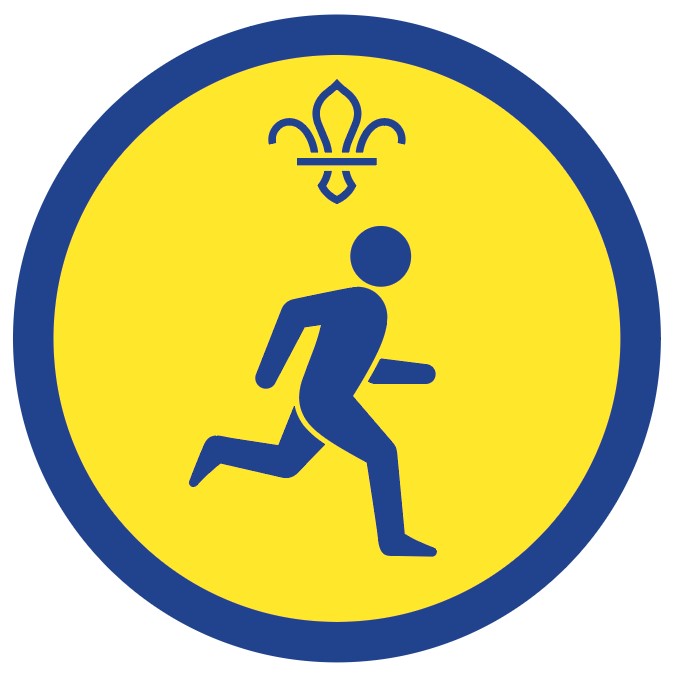
Tiny tennis tournaments
You’ll need
- Rope
- Something to mark lines (for example, chalk, masking tape, or rope)
- Big pieces of paper
- Permanent markers
- Tennis rackets
- Tennis balls
- Different coloured hoops (or rope or string)
- Wooden stakes (optional)
- Wooden mallet (optional)
Before you begin
- Use the safety checklist to help you plan and risk assess your activity. Additional help to carry out your risk assessment, including examples can be found here. Don’t forget to make sure all young people and adults involved in the activity know how to take part safely.
- Make sure you’ll have enough adult helpers. You may need some parents and carers to help if you’re short on helpers.
Setting up this activity
- Tie lengths of rope between a pair of trees at the players’ hip height to create a tennis net. If there aren’t trees, carefully use a wooden mallet to drive wooden stakes into the ground. Attach the rope to these to create nets.You’ll need around a 10-metre wide space of net per pair.
- You’ll need at least two makeshift nets for the bases Volley good fun and Twister tennis.
- You’ll need an umpire to run each base. They should explain the challenge, make sure everyone follows the rules, and note down people’s scores.
- This activity works best when the four bases are run at the same time.
- Each base should have an umpire who will call out the different challenges involved in each game, and mark down players’ scores.
Get ready to play
- Everyone should split into four groups.
- Each group should go to a different base and complete the activity.
- The person leading the activity should tell everyone when to move on and complete their second, third, and fourth base.
Volley good fun
- Everyone should get into pairs.
- Each pair should find a space where they can stand two or more metres apart from each other (and everyone else). One person should be on each side of the net and each pair should be opposite each other.
- Each person should get their own tennis racket. Each pair should get a tennis ball.
- One person should throw the ball over the net, and their partner should forehand volley it back.
A volley is when a ball is returned before it touches the ground – the ball must be hit in the air before it bounces on the ground.
- The person who threw the ball should catch the volleyed return, and throw the ball back again to their partner.
- Each pair should continue like this, counting how many volleys are returned and caught in a row without the ball touching the ground.
They should give the umpire their best number of volleys and catches in a row.
- Each pair should switch over, so that the person throwing and catching the ball is now volleying it.
Again, count how many volleys are returned and caught in a row and give this number to the umpire.
Footwork frenzy
- Everyone should find a space.
- The umpire should call out a footwork movement, such as: jog, side shuffle, hop on one foot, kneel, or stand on the spot.
- If the umpire calls out ‘Umpire says jog’, then everyone should do this movement.
- If the umpire simply calls out ‘jog’, then everyone should continue with the movement they were already doing.
- If anyone does the wrong movement (or switches movements without being told ‘Umpire says’), they’re out of the game.
- Give the winner some points, and play the game a few times, noting down everyone’s scores.
Twister tennis
- Everyone should get into pairs.
- Each pair should find a space where they can stand around one or two metres apart and away from everyone else to prevent hitting each other. One person should be on each side of the net and each pair should be opposite each other.
- Each person should get their own tennis racket. Each pair should get a tennis ball
- The umpire should call out a way of hitting the ball, such as: forehand, backhand, both hands, over your head, and under a leg.
- One half of the pair should throw the ball to their partner, who should hit it back using the technique the umpire has specified.
- The person who threw the ball should catch it and throw back to their partner.
- After a few throws and return hits, the umpire should switch the way of hitting the ball.
Continue doing this every few throws and hits.
- Each pair should count how many hits are returned and caught in a row, and after give their best score to the umpire.
- Each pair should switch over, so the person throwing and catching the ball is now hitting it.
Serve it up
- The umpire should mark out a service line using rope, sticks, stones, jumpers, or whatever else is available.
- The umpire should put some different coloured hoops at varying distances from the line.
You could also make your own hoops with rope, string, sticks, stones, or whatever else you have available.
- The umpire should tell everyone how many points each hoop is worth. The hoops that are furthest away from the service line should be worth more points.
- Everyone should take it in turns to throw a ball overhead from the service line and try to bounce it in one of the hoops.
- Everyone should have the same number of turns to make the scores fair. Confident tennis players could use a racket to serve the ball into one of the hoops.
- The umpire should mark down the points each player achieves.
And the winner is…
- Once everyone’s had a go at every base, everyone should gather together as a whole group.
- The umpire for each base should announce the winning person or pair. You could bring along some prizes or certificates.
- Everyone should take it in turns to share the player they think: improved the most, didn’t give up when they found something difficult, and encouraged and cheered on others.
Reflection
This activity was all about having fun while being active. Which game did everyone enjoy most? Why was that one the most enjoyable?
Some people may have preferred the games in pairs, while others may have liked getting stuck into the Serve it up challenge solo.
Perhaps some people found Twister tennis easier than Footwork frenzy, or were more confident in some skills than others. Did people prefer the bases that they found easier, or did they enjoy challenging themselves to improve their skills?
Why not plan another tiny tennis tournament to wrap up this session? Ask everyone which games they want to include, and if there are any other games they know of which develop tennis-specific skills.
Safety
All activities must be safely managed. You must complete a thorough risk assessment and take appropriate steps to reduce risk. Use the safety checklist to help you plan and risk assess your activity. Always get approval for the activity, and have suitable supervision and an InTouch process.
- Sharp objects
Teach young people how to use sharp objects safely. Supervise them appropriately throughout. Store all sharp objects securely, out of the reach of young people.
- Contact games and activities
Make sure everyone understands what contact is acceptable, and monitor contact throughout the activity.
- Outdoor activities
You must have permission to use the location. Always check the weather forecast, and inform parents and carers of any change in venue.
You can make Volley good fun harder by adding a round of backhands.
For a challenging version of Volley good fun and Twister tennis, remove the throwing and catching of the ball and have both players rally. (A rally is a sequence of continuous hits of the ball. The rally ends when a player misses a ball or the ball’s hit outside the court.)
You can adjust the difficulty of Serve it up by changing the placement of the hoops.
Make it accessible
All Scout activities should be inclusive and accessible.

